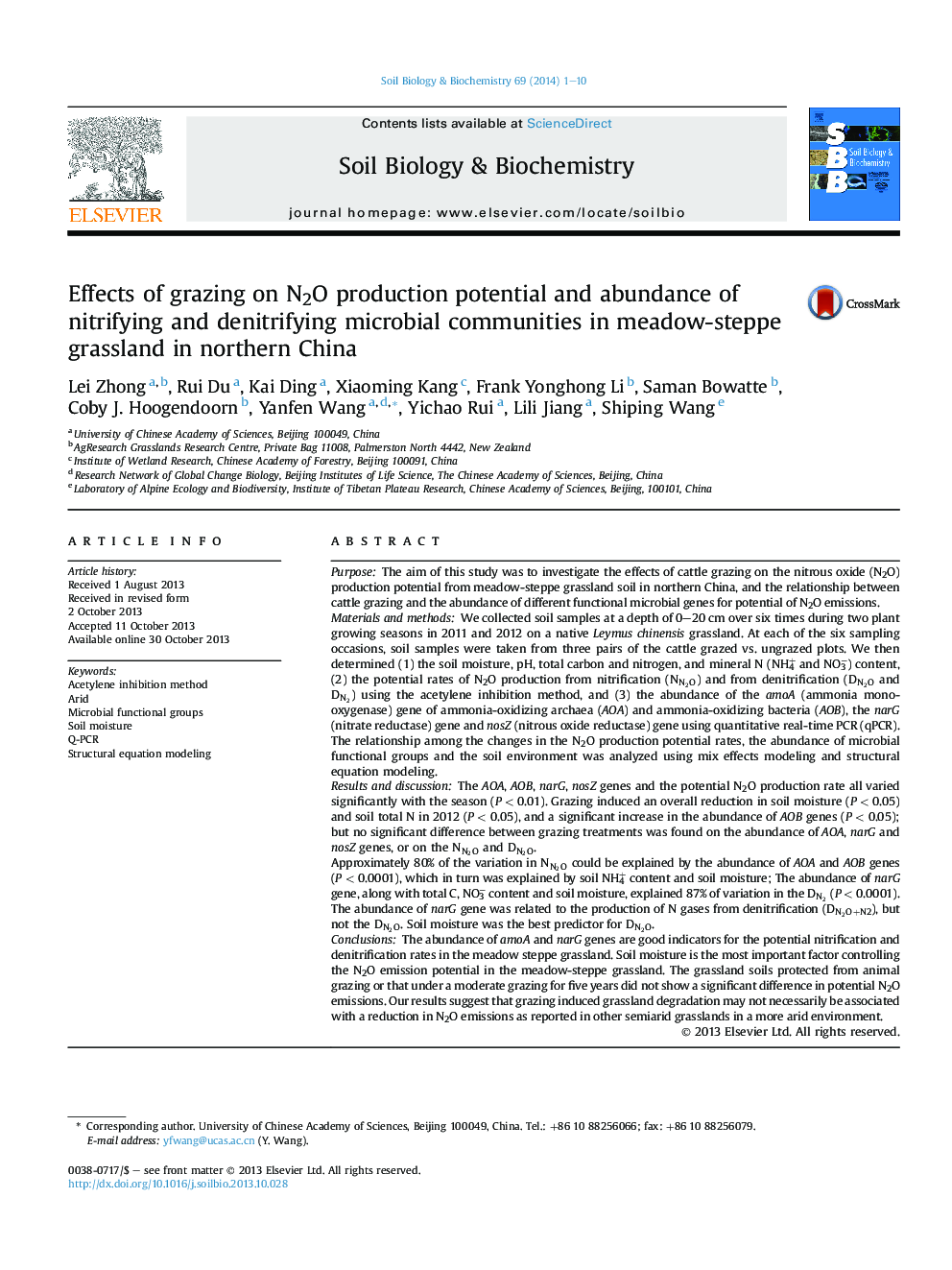| کد مقاله | کد نشریه | سال انتشار | مقاله انگلیسی | نسخه تمام متن |
|---|---|---|---|---|
| 2024706 | 1542615 | 2014 | 10 صفحه PDF | دانلود رایگان |

• We found that amoA and narG genes are good indicators on N2O production potential.
• Soil moisture is the most important factor controlling the N2O emission potential.
• Grazing for five years did not significantly effect on the N2O emission potential.
PurposeThe aim of this study was to investigate the effects of cattle grazing on the nitrous oxide (N2O) production potential from meadow-steppe grassland soil in northern China, and the relationship between cattle grazing and the abundance of different functional microbial genes for potential of N2O emissions.Materials and methodsWe collected soil samples at a depth of 0–20 cm over six times during two plant growing seasons in 2011 and 2012 on a native Leymus chinensis grassland. At each of the six sampling occasions, soil samples were taken from three pairs of the cattle grazed vs. ungrazed plots. We then determined (1) the soil moisture, pH, total carbon and nitrogen, and mineral N (NH4+ and NO3−) content, (2) the potential rates of N2O production from nitrification (NN2ONN2O) and from denitrification (DN2ODN2O and DN2DN2) using the acetylene inhibition method, and (3) the abundance of the amoA (ammonia monooxygenase) gene of ammonia-oxidizing archaea (AOA) and ammonia-oxidizing bacteria (AOB), the narG (nitrate reductase) gene and nosZ (nitrous oxide reductase) gene using quantitative real-time PCR (qPCR). The relationship among the changes in the N2O production potential rates, the abundance of microbial functional groups and the soil environment was analyzed using mix effects modeling and structural equation modeling.Results and discussionThe AOA, AOB, narG, nosZ genes and the potential N2O production rate all varied significantly with the season (P < 0.01). Grazing induced an overall reduction in soil moisture (P < 0.05) and soil total N in 2012 (P < 0.05), and a significant increase in the abundance of AOB genes (P < 0.05); but no significant difference between grazing treatments was found on the abundance of AOA, narG and nosZ genes, or on the NN2ONN2O and DN2ODN2O.Approximately 80% of the variation in NN2ONN2O could be explained by the abundance of AOA and AOB genes (P < 0.0001), which in turn was explained by soil NH4+ content and soil moisture; The abundance of narG gene, along with total C, NO3− content and soil moisture, explained 87% of variation in the DN2DN2 (P < 0.0001). The abundance of narG gene was related to the production of N gases from denitrification (DN2ODN2O+N2), but not the DN2ODN2O. Soil moisture was the best predictor for DN2ODN2O.ConclusionsThe abundance of amoA and narG genes are good indicators for the potential nitrification and denitrification rates in the meadow steppe grassland. Soil moisture is the most important factor controlling the N2O emission potential in the meadow-steppe grassland. The grassland soils protected from animal grazing or that under a moderate grazing for five years did not show a significant difference in potential N2O emissions. Our results suggest that grazing induced grassland degradation may not necessarily be associated with a reduction in N2O emissions as reported in other semiarid grasslands in a more arid environment.
Journal: Soil Biology and Biochemistry - Volume 69, February 2014, Pages 1–10